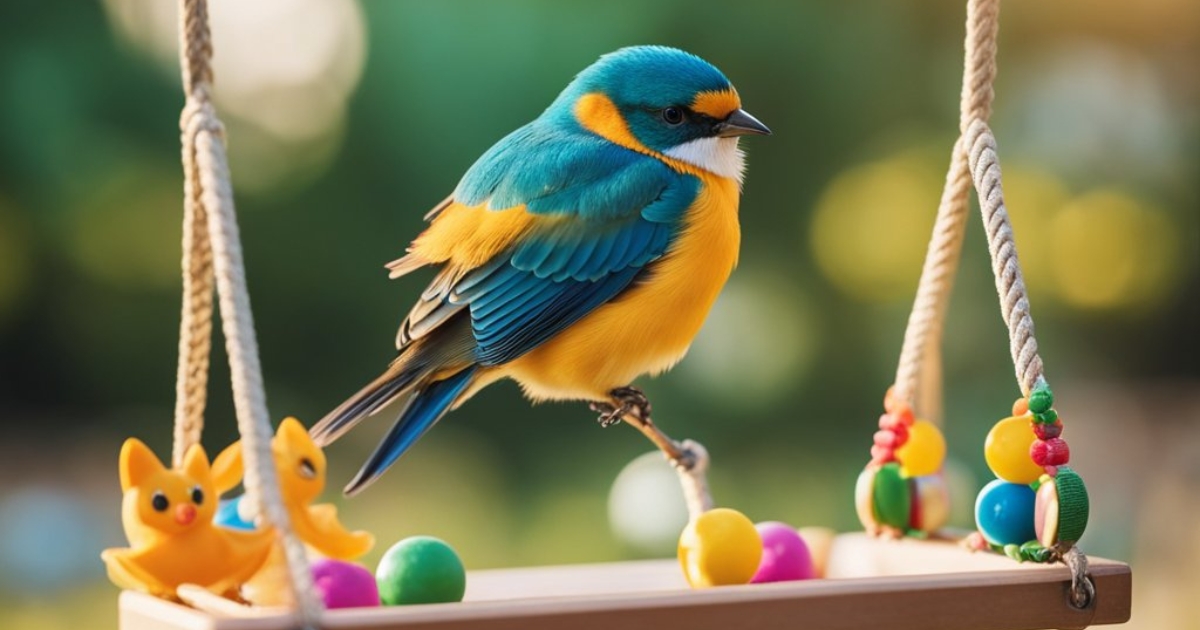Owning a pet bird can be an incredibly rewarding experience. Birds make fun, affectionate, and intelligent companions. However, they also require specific care and attention in order to thrive. As a bird owner, it is your responsibility to provide your feathered friend with proper nutrition, housing, social interaction, and medical care.
While caring for a pet bird does take time and effort, it is easier than you may think. There are simple things you can do every day to keep your bird happy and healthy. In this article, we will cover the 10 most important tips for maintaining your bird’s well-being. Follow these key steps, and you can feel confident knowing your beloved bird is living its best life!
1. Provide a Proper Diet
One of the most basic but critical aspects of bird care is providing the right diet. Different bird species have varying nutritional needs, so it is important to do your research. As a general rule, most pet birds should be fed a high-quality seed mix designed specifically for that type of bird. Supplement with fresh vegetables, fruits, greens, and healthy foods.
Research Your Bird’s Nutrition Requirements
Spend time learning about what foods your particular bird needs. Parrots, for example, thrive on combinations of seeds, pellets, fruits, and veggies. Finches and canaries have simpler diets focused on seeds. Do not just assume you know what to feed your bird; confirm its specific needs.
Select a Reputable Bird Food Brand
Not all bird foods are created equal. Look for ones made by reputable pet food companies that use top-quality ingredients. Avoid cheap seed mixes with lots of filler. Stick to food specifically formulated for your bird species.
Provide Fresh Fruits and Vegetables
In addition to the main bird food, offer fresh produce like broccoli, berries, kale, carrots, and apples. Chop pieces small or hang veggies in cages. Ensure variety, rotating different produce. Vegetables and fruits provide essential vitamins and nutrients.
2. Give Your Bird Lots of Fresh Water
Water is one of the most vital things your bird needs to stay healthy. Ensuring constant access to clean, fresh drinking water is a must. Take steps to provide water and refresh it frequently.
Use Proper Water Dishes
Use dishes designed for bird use, like those with hooks to attach inside cages. Select a size appropriate to your bird’s needs. Shared waterers for multiple birds must be big enough.
Change Water Daily
Empty and refresh water dishes every day. Dumping out old water removes built-up debris and algae that can make birds sick if consumed. Refilling with clean water gives them a fresh supply.
Keep Dishes Clean
Sanitize water containers weekly, or more often if they are visibly dirty. Use hot water and bird-safe disinfectant. Rinse thoroughly afterwards. This prevents dangerous bacteria and mold from accumulating.
3. Allow Plenty of Out-of-Cage Time
While cages keep birds safe, your pet needs opportunities to spread its wings. Allowing substantial out-of-cage time supports exercise and mental stimulation. Aim to let birds fly free for several hours daily.
Enable Uncaged Flight
Birds thrive when given time to fly around rooms, get exercise, and interact with human companions. Open cages daily so they can take short flights and return freely. Supervise for safety.
Bird-Proof Your Home
Before giving birds free rein, ensure the area is hazard-free. Block ceiling fans, hide wires, remove toxins, and take other precautions. Start by bird-proofing one room, then expand access. Always monitor birds that are loose.
Set a Flight Goal
Aim for a minimum of 4-6 hours of uncaged flight time per day, if possible. Track time and increase gradually. Active time out of the cage is essential to a bird’s health and happiness. More is better!
4. Offer Fun Toys and Activities
Just like kids, birds need play time! Provide an array of fun toys and activities to prevent boredom and enhance mental stimulation. Rotate new toys in to keep things interesting. Allow supervised interactive play every day.
Select Safe, Engaging Toys
Look for bird-safe toys made of natural wood, rope, and paper. Good options include chew toys, shredders, bells, and more. Ensure that toys have no small, toxic parts that could be swallowed. Various shapes and textures.
Try Foraging Activities
Set up treasure hunts by hiding treats on paper and letting your bird shred and search. Place foods like sprouts and greens in a bowl under toys so your pet has to dig through. This mimics natural foraging behavior.
Rotate Toys Frequently
Switch out toys weekly by adding 1-2 new ones and removing others. Rotation prevents boredom and makes existing toys seem new again. Mix it up to pique your bird’s curiosity.
5. Create a Bird-Friendly Environment
Your bird’s habitat has a big impact on its mood and health. Ensure proper lighting, temperature, space, and safety. Evaluate the cage location and accessories to create an enriching atmosphere.
Provide Proper Lighting
Natural light from a window is ideal, but supplement with overhead lighting on shorter winter days. Optimal brightness mimics daylight cycles. Avoid completely dark or very bright environments.
Maintain Comfortable Temperatures
The ideal temperature range depends on species, but generally between 65-85° F is recommended. Avoid drafty areas. Purchase thermometers to monitor temperature fluctuations.
Add Enriching Accessories
Furnish your habitat with perches, branches, baths, tents, mirrors, and other engaging accessories. Include natural wood and rope perches of varying widths and textures.
Set Up Cage in Safe Location
Pick a low-traffic area away from drafts, direct sunlight, noise, and kitchen dangers like nonstick pans. Raise the cage off the floor to the bird’s eye level for security. Near-family activities prevent loneliness.
6. Give Your Bird Your Time and Attention
You are your bird’s flock! Social interaction with you is a major component of your pet’s health. Spend individual time with your bird daily through positive handling, training, and bonding. Watch for signs of loneliness.
Make Individual Handling Enjoyable
Gently handle birds often so they become comfortable with you. Use treats, speak soothingly, and stroke the head and neck. Move slowly to build trust. Short, positive sessions prevent stress.
Try Training for Bonding
Use clicker training and treats to teach fun tricks like spinning and fetching. This builds trust and stimulates your mind. Even 10 minutes daily makes a difference. Make it a routine.
Watch for Social Issues
Pay attention to cues like screaming, biting, pacing, or plucking, which may indicate boredom, anxiety, or distress from inadequate social time. Increase human companionship if this occurs.
7. Maintain Proper Grooming
Birds need regular grooming maintenance, like nail and beak trims. Keeping feathers neat and tidy also prevents issues. Schedule monthly at-home care between vet visits.
Trim Overgrown Beaks and Nails
Using proper bird nail clippers, carefully trim each nail, not too quickly. File upper beak if overgrown only. Providing “chew” toys helps wear beaks down naturally.
Clean Ceres and Vent Areas
Use gentle wipes to clear nasal discharge, food debris, and droppings around the eyes, nose, mouth, and vent. Q-tips dipped in warm water work well. Dry thoroughly after.
Ensure Healthy Feather Condition
Check for damaged feathers or excessive plucking. Provide baths, mister showers, and preening toys. If issues persist, see an avian vet to address the underlying causes.
8. Prioritize Good Sleep Habits
Birds need 10-12 hours of uninterrupted sleep per night for optimal health. Establish proper sleep routines and environments to ensure your pet gets adequate rest.
Keep Cages Covered at Night
Drape cages after dusk to signal bedtime and block light/noise that can prevent sleep. Breathable fabric lets in air flow. Be consistent with coverings.
Follow Natural Sleep Cycles
Put birds to bed when it gets dark and wake at sunrise to match natural patterns. Avoid artificial light at night. Adjust the schedule with seasonal light changes.
Remove Night Frights
Eliminate disturbances that trigger night frights where birds frantically fly and injure themselves indoors. Trigger examples include lights, sounds, and unfamiliar objects.
9. Practice Proper Sanitation
Dirty cages and food dishes rapidly spread harmful bacteria and illnesses. Stick to a strict sanitation schedule. Disinfect cages weekly or more often if needed.
Clean Food and Water Dishes Daily
Dump, scrub, and refill water dishes daily, as mentioned before. Likewise, empty and wash food containers to prevent mold, bacteria, and ants. Air-dry completely.
Schedule Weekly Cage Cleanings
Take cages outdoors weekly for deep cleaning. Remove perches, toys, and bowls first for individual cleaning. Use bird-safe disinfectant, then rinse and dry thoroughly.
Sanitize Toys, Perches and Surfaces
In addition to cages, disinfect hard surfaces birds come into contact with at least biweekly. Scrub and disinfect toy components before reassembling. Keeping areas clean promotes health.
10. Schedule Annual Checkups
Just like dogs and cats, birds need well-being visits with an avian vet for exams, lab work, and preventative care. Scheduled checkups can catch issues early.
See an Avian Vet Yearly
Find an experienced bird vet and bring your pet in annually at minimum. Some birds may need biannual exams, depending on their age and species. Regular vet care is crucial.
Undergo Recommended Testing
Discuss lab work with your vet to identify any viral, bacterial, or fungal infections before they become problems. Common tests include cultures, blood panels, DNA, and X-rays.
Get Preventative Care
Vets provide key services like wing trims, nail trims, cleanings, and vaccinations. Preventative care tailored to your bird’s needs improves long-term health. Stay on schedule.
People Also Read:
Conclusion
Caring for a pet bird has so many fantastic benefits, for both you and your feathered companion. However, birds are a big commitment, requiring diligent attention to their health and happiness. If you put in the effort to follow these 10 fundamental tips covered here, you can feel confident that your beloved bird will live a healthy, enriched life!
Providing excellent nutrition, housing, social bonding, and medical care may sound daunting at first. But in reality, it simply involves establishing some daily routines and schedules. With a little time invested each day, you can easily cover all your bird’s needs for a healthy mind and body. Your bird depends on you entirely for its well-being.
The key is sticking with these best practices on a consistent basis. Over time, a proper diet, clean water, exercise, toys, attention, and medical care will become a natural part of your bird’s daily rhythm. Any extra effort to go above and beyond will make an even bigger difference in your pet’s happiness.
If you commit to this small set of simple daily steps, you will likely find bird ownership easier and more rewarding than you imagined. You will forge a close bond built on trust and enrich your bird’s life immensely. So read up on your feathered friend’s unique needs, set up its habitat, and get ready to have an amazing companion animal by your side for years to come!
Frequently Asked Questions
Q: How often should I clean my bird’s cage?
A: A thorough cleaning of the entire cage should be done at least once per week. Daily spot cleanings are also recommended of dishes, perches and tray lining.
Q: What types of food should I avoid giving my bird?
A: Avoid avocado, chocolate, caffeine, alcohol, fruit seeds/pits, onions/garlic, sugary junk food. These can range from toxic to simply unhealthy for birds.
Q: How can I tell if my bird is getting enough exercise?
A: Signs of sufficient activity include flapping wings often, climbing cage bars, energetic vocalizations and playfulness. Sedentary birds may excessively sleep and seem listless.
Q: What temperature range do most pet birds need?
A: The optimal temperature range for most pet birds is 65-85°F. Particular species may have more narrow ideal temps, so research yours specifically.
Q: How do I bond with a new bird?
A: Bond through hand-feeding treats, positive handling, clicker training and supervised out-of-cage play time. Spend dedicated one-on-one time getting the bird comfortable with you.

